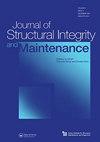热负荷腐蚀指数梯度转子-轴承系统的基频分析
IF 3.1
Q2 ENGINEERING, CIVIL
Journal of Structural Integrity and Maintenance
Pub Date : 2021-10-02
DOI:10.1080/24705314.2021.1892574
引用次数: 2
摘要
腐蚀是材料在恶劣的环境条件下发生的一种非故意的降解。它是一种导致材料损失的表面现象,影响任何结构的动力特性和结构完整性。本文介绍了用有限元法对腐蚀功能梯度转子轴承系统进行弯曲振动的基频分析。考虑了一种功能分级(FG)轴,不锈钢作为内部金属芯,氧化锆作为外部陶瓷层。采用指数级配法,沿轴向分配材料性能。本文采用基于傅立叶热传导定律的指数温度分布法(ETD)计算了FG轴横截面上的温度分布。利用Timoshenko梁理论建立了腐蚀FG轴单元的有限元计算公式。为了研究腐蚀对基频的影响,编制了FG转子-轴承系统在腐蚀长度、位置、深度和热梯度等不同参数下的固有频率和旋转频率的有限元计算程序。研究了腐蚀参数对FG转子-轴承系统固有频率和旋转频率的显著影响。本文章由计算机程序翻译,如有差异,请以英文原文为准。
Fundamental frequency analysis of a thermally loaded corroded exponentially graded rotor bearing system
ABSTRACT Corrosion is an unintentional degradation of a material, which transpires due to harsh environmental conditions. It is a surface phenomenon that results in loss of material, which affects the dynamic characteristics and structural integrity of any structure. Fundamental frequency analysis of a corroded functionally graded (FG) rotor-bearing system using finite element method (FEM) for flexural vibrations is presented in work. A functionally graded (FG) shaft, Stainless Steel as the inner-metal core and Zirconia as the outer-ceramic layer is considered. Exponential gradation law is followed to assign the material properties along the radial direction of the shaft. The exponential temperature distribution (ETD) method based on Fourier law of heat conduction has been used for the temperature distribution across the cross-section of the FG shaft. Finite element formulations of a corroded FG shaft element have been developed using Timoshenko beam theory. An FE code is developed to compute the natural and whirl frequencies of an FG rotor-bearing system for various parameters such as corrosion length, position, depth and thermal gradients to investigate the influence of corrosion on fundamental frequencies. It has been investigated that there is a significant influence of corrosion parameters on the natural and whirl frequencies of an FG rotor-bearing system.
求助全文
通过发布文献求助,成功后即可免费获取论文全文。
去求助
来源期刊

Journal of Structural Integrity and Maintenance
ENGINEERING, CIVIL-
CiteScore
3.90
自引率
9.50%
发文量
24
 求助内容:
求助内容: 应助结果提醒方式:
应助结果提醒方式:


